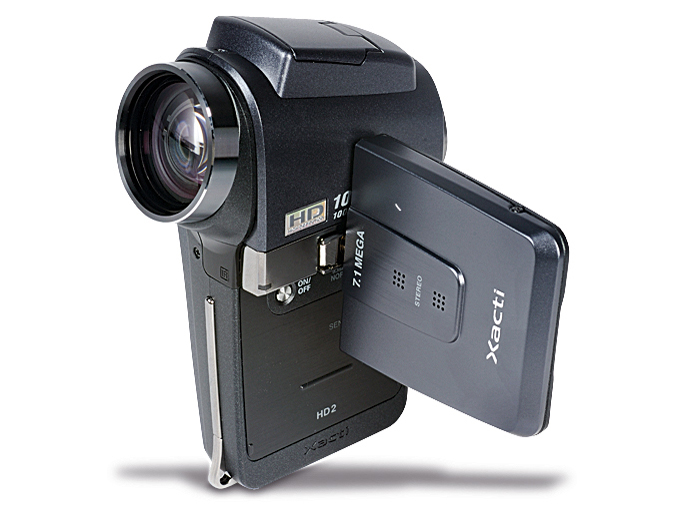TechRadar Verdict
Affordable and full of features, but its images fall well short of the quality we'd expect from an HD cam
Pros
- +
Light, portable
Easy to use
Cheapest HD cam on the market
7.1 megapixel digital stills
Cons
- -
Difficult to differentiate between SD and HD pictures
Poor positioning of microphone
Why you can trust TechRadar
When compared to the other HDV camcorders we've looked at in the past few months, the HD2 is something of an anomaly.
For starters, it's produced by Sanyo, a manufacturer that isn't commonly considered one of the camcorder stalwarts and, what's more, its HD footage is compressed in the MPEG4 codec. However, initial appearances suggest that Sanyo might be about to make a name for itself as a camcorder manufacturer, particularly when you consider the £440 price tag that makes this the cheapest HD cam on the market.
Looking at the features list it's difficult to figure out exactly what corners have been cut to achieve such an impressive price. One thing is clear, however: it's certainly not on the spec sheet.
The HD2 is obviously designed for the YouTube moviemaker who shoots funny events as and when they happen, rather than the serious enthusiast who's a bit more discerning about their video camcorder's functionality. Having said that, this cam has far more features than a sub-£500 model has any right to.
HD footage boasts 1,280 x 720-pixel resolution at 30fps (frames per second), while SD options vary from 720 x 480 pixels at 30fps right down to 320 x 240 at 15fps.
Manual overrides include the usual focus, exposure and white balance, while there are also options for adjusting the 'quality' of shots and a flicker control for use with fluorescent lighting. Footage can be saved in either 4:3 or 16:9 aspect ratios and can be output in either 720p or 480p.
The HD2 is also capable of capturing digital stills, boasting an astonishing maximum resolution of 3,680 x 2,760 pixels. Both stills and video are stored onto SD or SDHC cards, although neither is bundled with the cam, meaning that the £440 price tag is more likely to creep up towards the £500 mark. But that's still 50 per cent less than most half decent HD models.
Connection to an HD Ready plasma or LCD screen comes in the form of component video or HDMI. Cleverly, the HD2 doesn't have the sockets on its chassis, instead it plugs into a base station, which houses the socketry in order to minimise the cam's size.
While the features are impressive, the build quality of the HD2 is less so. The chassis is ridiculously light and, though it won't weigh you down when shooting, feels insubstantial, as if it won't take much more than an accidental knock to put the device permanently out of action.
It's not held in the conventional way either, and can best be compared to a Star Trek phaser. Fun for Trekkies this may be, but without the support of a handgrip shooting for much longer than a couple of minutes gets pretty uncomfortable.
Having said that, the positioning of the major controls at the rear make for simple, no-nonsense operation, while the onscreen interface is pretty intuitive to navigate around.
On the downside, the 2.2in LCD screen seems just too small to be of any practical use and has 4:3 dimensions, even though there's a 16:9 shooting mode. Also irksome is the positioning of the built-in microphone on the front of the screen. This is certain to pick up handling noise and sounds coming from behind the lens.
Unfortunately, the bad news continues when it comes to the pictures, which are about as far away from what we'd expect from an HD cam as it's possible to get.
Admittedly, the overexposure and the poor colour reproduction are more to do with the automatic metering system than with its hi-def capability, but HD is all about image detail and there simply isn't enough on show here.
Viewed on a 42in LCD screen small print becomes a messy blur, complex patterns suffer from dot crawl and excessive noise, while fine details that don't present any problem to rival models are impossible to make out. So disappointing is the lack of clarity that it's nigh on impossible to differentiate between standard-definition and HD pictures.
The positives, limited though they are, occur with the auto focus, which reacts with smooth alacrity and the stills mode, which captures far more detail than the video camera could ever dream of. Since we're more interested in moving pictures than the stills, the HD2 is something of a wash-out.
Ultimately, an HDV camcorder's success rests on how good it's pictures are. It's all very well having stunning features and a snazzy chassis, but something is wrong if the images aren't at the very least superior to standard-definition.
Sadly, this is the case with the VPC-HD2 and it's difficult to believe that these images are being passed off as HD quality. Though Sanyo's endeavour is to be admired and the concept is fine in theory, in practice it fails to live up to expectation.
Tech.co.uk was the former name of TechRadar.com. Its staff were at the forefront of the digital publishing revolution, and spearheaded the move to bring consumer technology journalism to its natural home – online. Many of the current TechRadar staff started life a Tech.co.uk staff writer, covering everything from the emerging smartphone market to the evolving market of personal computers. Think of it as the building blocks of the TechRadar you love today.
